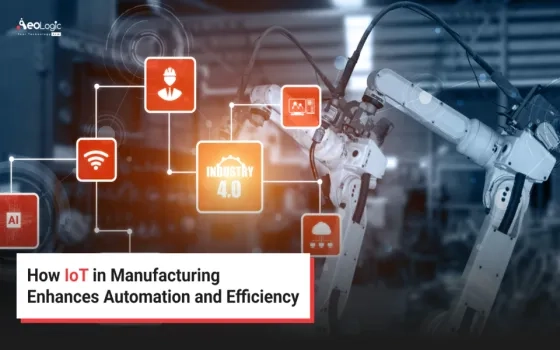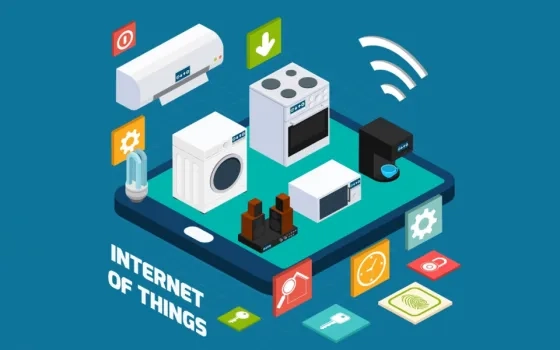The Internet of things is the result of a technically advanced world that is moving ahead of its time. With many inventions and innovations that aim to change the way the world works, many try to link everything together to form an information chain. One such paradigm of innovation is IoT Development which is the culmination of hardwired information, with software. IoT stands for the integration of the physical world, with the digital platform, with the help of sensors, detectors, or any other technology that sends the feedback of a physical instrument to a software.
With new applications of the IoTs taking over the world, many industries also have started to implement the use of IoTs in their production processes. It is being regarded as the solution to the inefficiency of the industries. IIOT manufacturing is playing a major role in increasing the production rate, as well as improving the quality. The machines are integrated with different sensing devices that send data to software. This makes it very easy to monitor the functioning of every machine, and use the results obtained effectively to make changes. This increases the efficiency of the machines and also improves the quality of the product.
Role of Industrial IOT on a global scale
The world is moving towards a technological transformation and since it has held the hands of IoT, it is propelling the revolutions in the right direction. There have been many industrial revolutions, that aimed to change the face of manufacturing industries. And, then is the IoTs, which are revolutionizing every manufacturing industry to meet their efficiency as well as improve the quality. The industry movement 4.0 was brought forward with the sole purpose of automating the entire production process. Also, along with automation, creating an analytical scheme to enhance the monitoring approach is what the IoTs have brought along with them.
The machines on the production line were embedded with devices that were integrated with IoT and worked together to provide the best output. It also allows the collection of production data, automate recovery processes, and runs active maintenance services. This ensures that there are no errors and issues with the production line, which will maintain the flow of production with the highest quality.
Impact of Industrial IoT
IIOT manufacturing has one purpose, carefully access the workflow of different industrial machines and enhance their automation processes. But it is not only limited only to automation processes, in this article we are going to understand in a better way, how Industrial IoTs are impacting the manufacturing processes. Therefore, let us understand more broadly, what is the impact of Industrial IoT Development on different aspects of manufacturing.
-
Improves the maintenance process
One of the most important factors in a production line is the maintenance of all the machines and integrated systems. However, maintenance is one such process that takes a lot of time and resources. Additionally, in cases of industry drive maintenance, it can cause a loss of efficient time and resources. Maintenance requires process planning and systematic processing to not tamper with the manufacturing process, and also maintain the quality.
IIOT manufacturing has made the maintenance process very easy and systematic. It provides a better insight into every individual machine integrated into the production line. It provides detailed data on every piece of equipment and makes it easy for the manufacturer to understand which element needs maintenance. It allows the manufacturer to predict issues even before they occur and resolve the causing element so that it does not affect the production. This helps in reducing maintenance costs and reduce time loss.
-
Better Digitalization of every process
IoT Development was introduced in the industrial field with the sole purpose of connecting every physical element with the help of sensors to a digital platform, using integrated software. This allowed the manufacturers to increase productivity, enhance operations to improve quality, and also reduce any kind of manufacturing errors. The IoTs bring together every aspect of production to work collectively and move towards better results and quality.
This creates a better workflow that is fully automated and even sends scheduled reports of manufacturing. This produces a systematic flow of every smaller element that is important to work properly to provide better output. AI’s role in manufacturing has increased drastically over the past few years, as they provide the best automation when embedded with IoT tools.
With the introduction of IoT Development on different levels of production, the manufacturers easily control every aspect of the production line with the help of software and digital controlling systems. Before the Industrial 4.0 revolution began, the Smart factories experienced a setback while maintenance. There was no flexibility in production, and it cost them a loss of resources and time. However, with the integrated Industrial IoT, the manufacturers easily compensate for the lost time without reducing the production rate.
-
Enhanced Operational strategies
The best way to increase the production rate for any organization is to develop better production strategies. This is done by analyzing the previous production data and looking for elements that reduced the work efficiency. Thus, it allows you to improve upon the production strategies, and get the desired quality of the product in a reduced time.
-
Better Cost-effectiveness
One of the best features of IIOT manufacturing is that they are very cost-efficient. The sensors that are integrated into the systems have very cost-efficient. This increases the reliability and automation of the production line without too much updating cost. The IoTs often include basic sensors that are of low cost and self-diagnostic software that are cheap and can be integrated into the production line. Therefore, this allows a more productive manufacturing metric that is updated and provides easier workflow.
Application of Industrial IoT
Every industry is targeting to inculcate IoTs in their manufacturing process. With the increased efficiency and quality, many new applications have been developed. Smart factories can efficiently inculcate better automated production lines, that enhance the rate of production with increased quality.
Hence, with the beginning of the industrial 4.0 revolution, many industries are moving towards IoTs. They are inculcating better IoT technologies in their production line which are helping them to achieve better results. Therefore, let us understand all the applications that IoTs contribute to and what are the future of Industrial IoT.
Many UAVs, drones, and robotics industries embed various IoT’s into their vehicles to increase the automation process. This increases the safety measures and reduces any kinds of accidents that occur due to human intervention. This also allows easy control of these vehicles or production robots. The IoTs increase the compliance rate of any of the machines with the user’s interface and in turn, helps in increasing the quality with a better productivity rate.
-
Track all the company assets with IoT
The value of assets determines the worth of the producer. Therefore, a manufacturer must keep track of all the action as well as passive assets of their production. IoT Development allows the manufacturer to monitor all the assets remotely and indulge them with better processes. This creates a healthy collaborative environment among the producer and the suppliers.
-
Better management of the inventory
Industrial IoTs keep track of the inventory that is maintained in the manufacturing stores. It provides better control of all the aspects of inventory, and even sends reminders and reports that the inventory is being drained.
One of the best features that IoTs provides other than automation is the analysis it provides of different elements of the production processes. The IoTs study the present trend of the production system, relating to the productivity rate, efficiency, machine work efficiency, and creates a predictive report which states the future aspect of the production line. This is very helpful in understanding if the current production strategy has future benefits, or which machine element will maintenance and when.
A detailed productive analysis is highly appreciated and recommended to move towards development. And developing a workforce that will have better future results. This also allows the manufacturers to have a better insight into every small or big element that form the production line. Therefore, with these reports, you can always update the manufacturing strategy and move towards a better tomorrow.
-
Real-Time control of production line
A manufacturer sometimes has to stop a certain production line to make some changes to meet the needs of the customers. However, with Industrial IoT Development this can be done very easily. A manufacturer can control the production line remotely and make real-time changes to meet the requirement of the customer. This allows the manufacturer to create better relations with the customers as they provide customized products. This creates a better supply chain and creates a better action course, that benefits both the manufacturer and the customer.
Conclusion
The global market is filled with competitors and industries that are driven by passion and with a better workforce. And sometimes it becomes nearly impossible to compete with the market that is so advanced in itself that you would lag. However, with the introduction of industrial IoTs, the gap has started to decrease.
Source: How Industrial IoT is Transforming Product Design and Manufacturing
















